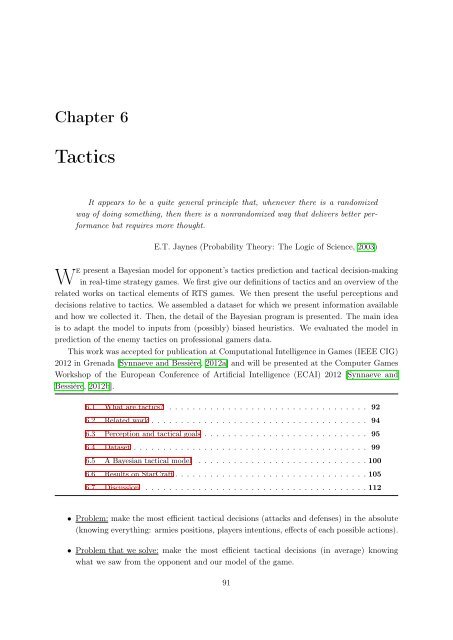Bayesian Programming and Learning for Multi-Player Video Games ...
Bayesian Programming and Learning for Multi-Player Video Games ...
Bayesian Programming and Learning for Multi-Player Video Games ...
Create successful ePaper yourself
Turn your PDF publications into a flip-book with our unique Google optimized e-Paper software.
Chapter 6<br />
Tactics<br />
It appears to be a quite general principle that, whenever there is a r<strong>and</strong>omized<br />
way of doing something, then there is a nonr<strong>and</strong>omized way that delivers better per<strong>for</strong>mance<br />
but requires more thought.<br />
E.T. Jaynes (Probability Theory: The Logic of Science, 2003)<br />
We present a <strong>Bayesian</strong> model <strong>for</strong> opponent’s tactics prediction <strong>and</strong> tactical decision-making<br />
in real-time strategy games. We first give our definitions of tactics <strong>and</strong> an overview of the<br />
related works on tactical elements of RTS games. We then present the useful perceptions <strong>and</strong><br />
decisions relative to tactics. We assembled a dataset <strong>for</strong> which we present in<strong>for</strong>mation available<br />
<strong>and</strong> how we collected it. Then, the detail of the <strong>Bayesian</strong> program is presented. The main idea<br />
is to adapt the model to inputs from (possibly) biased heuristics. We evaluated the model in<br />
prediction of the enemy tactics on professional gamers data.<br />
This work was accepted <strong>for</strong> publication at Computational Intelligence in <strong>Games</strong> (IEEE CIG)<br />
2012 in Grenada [Synnaeve <strong>and</strong> Bessière, 2012a] <strong>and</strong> will be presented at the Computer <strong>Games</strong><br />
Workshop of the European Conference of Artificial Intelligence (ECAI) 2012 [Synnaeve <strong>and</strong><br />
Bessière, 2012b].<br />
6.1 What are tactics? . . . . . . . . . . . . . . . . . . . . . . . . . . . . . . . . . . 92<br />
6.2 Related work . . . . . . . . . . . . . . . . . . . . . . . . . . . . . . . . . . . . . 94<br />
6.3 Perception <strong>and</strong> tactical goals . . . . . . . . . . . . . . . . . . . . . . . . . . . . 95<br />
6.4 Dataset . . . . . . . . . . . . . . . . . . . . . . . . . . . . . . . . . . . . . . . . 99<br />
6.5 A <strong>Bayesian</strong> tactical model . . . . . . . . . . . . . . . . . . . . . . . . . . . . . 100<br />
6.6 Results on StarCraft . . . . . . . . . . . . . . . . . . . . . . . . . . . . . . . . . 105<br />
6.7 Discussion . . . . . . . . . . . . . . . . . . . . . . . . . . . . . . . . . . . . . . 112<br />
• Problem: make the most efficient tactical decisions (attacks <strong>and</strong> defenses) in the absolute<br />
(knowing everything: armies positions, players intentions, effects of each possible actions).<br />
• Problem that we solve: make the most efficient tactical decisions (in average) knowing<br />
what we saw from the opponent <strong>and</strong> our model of the game.<br />
91


